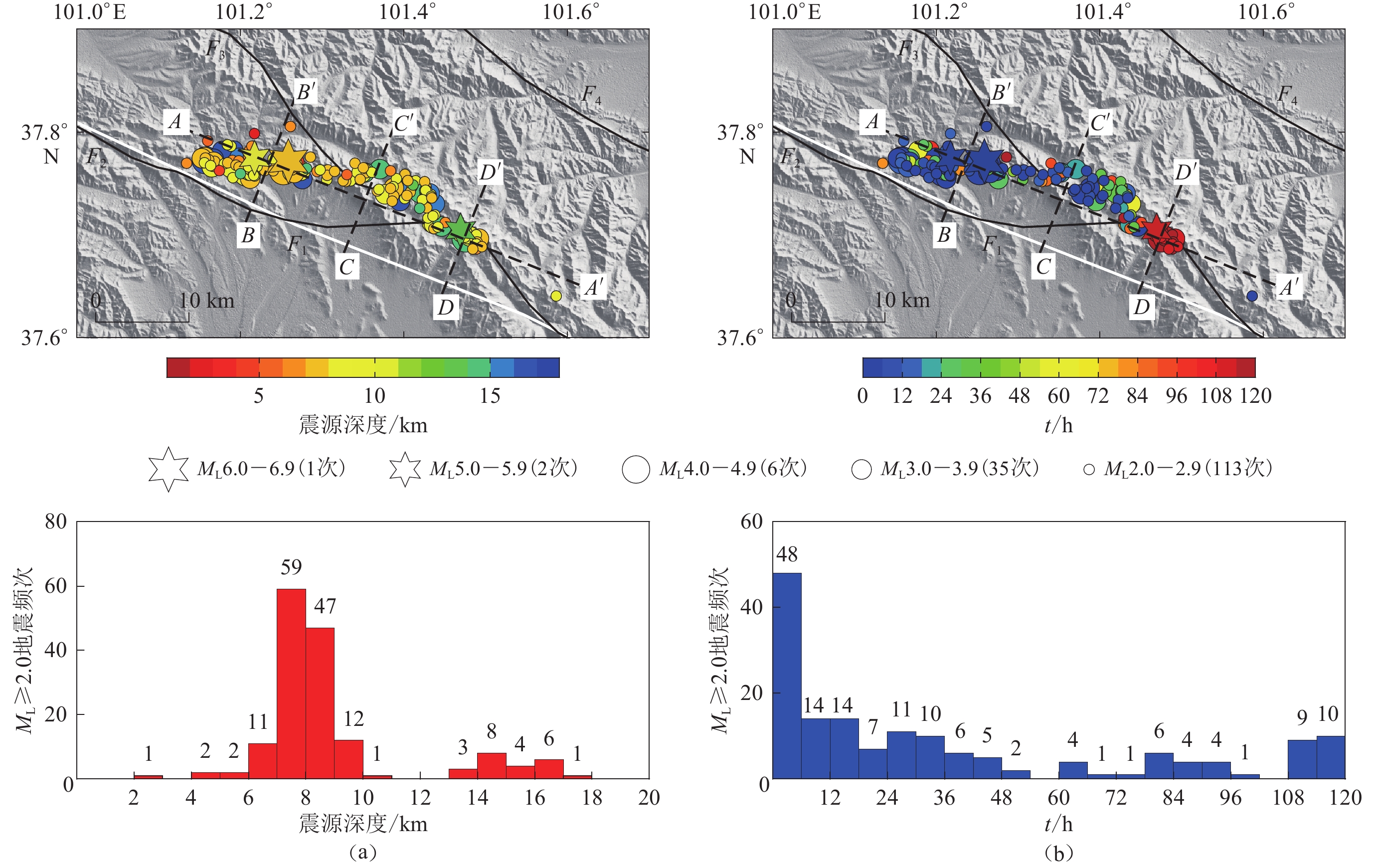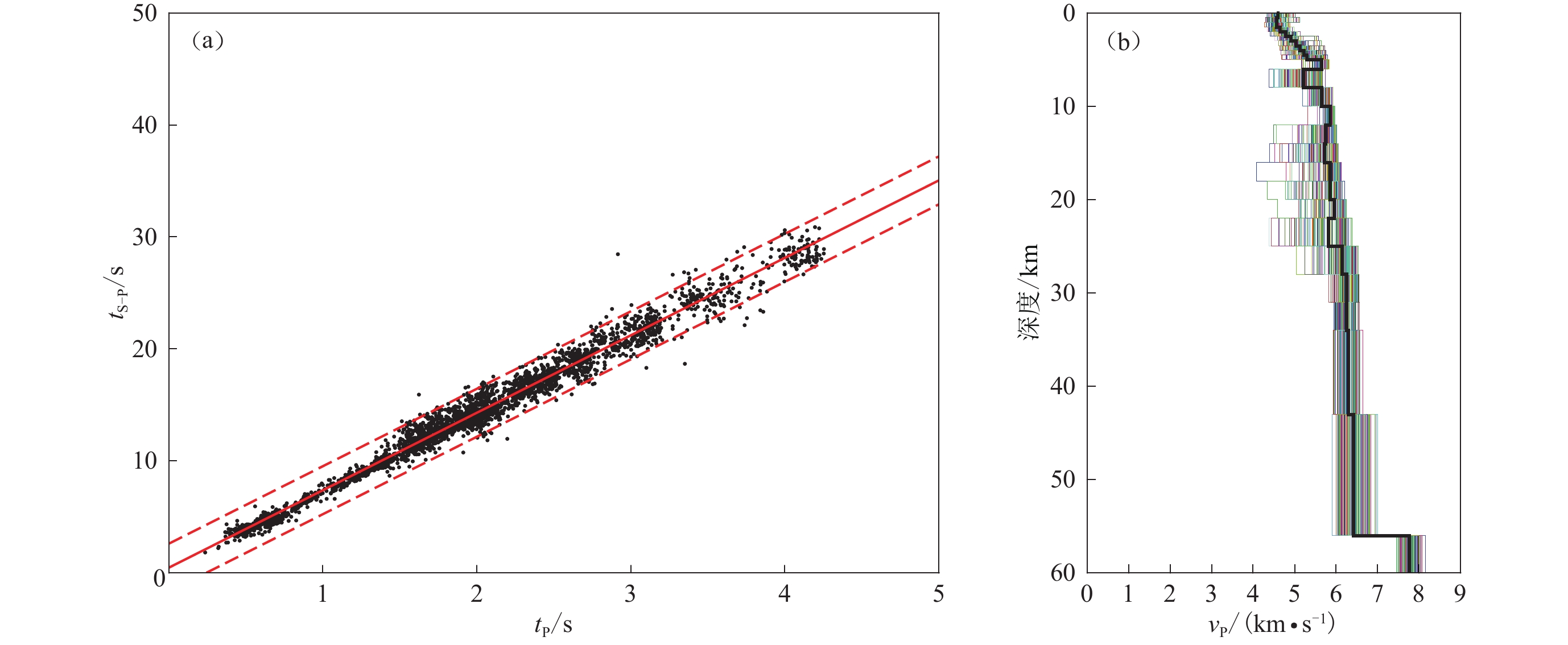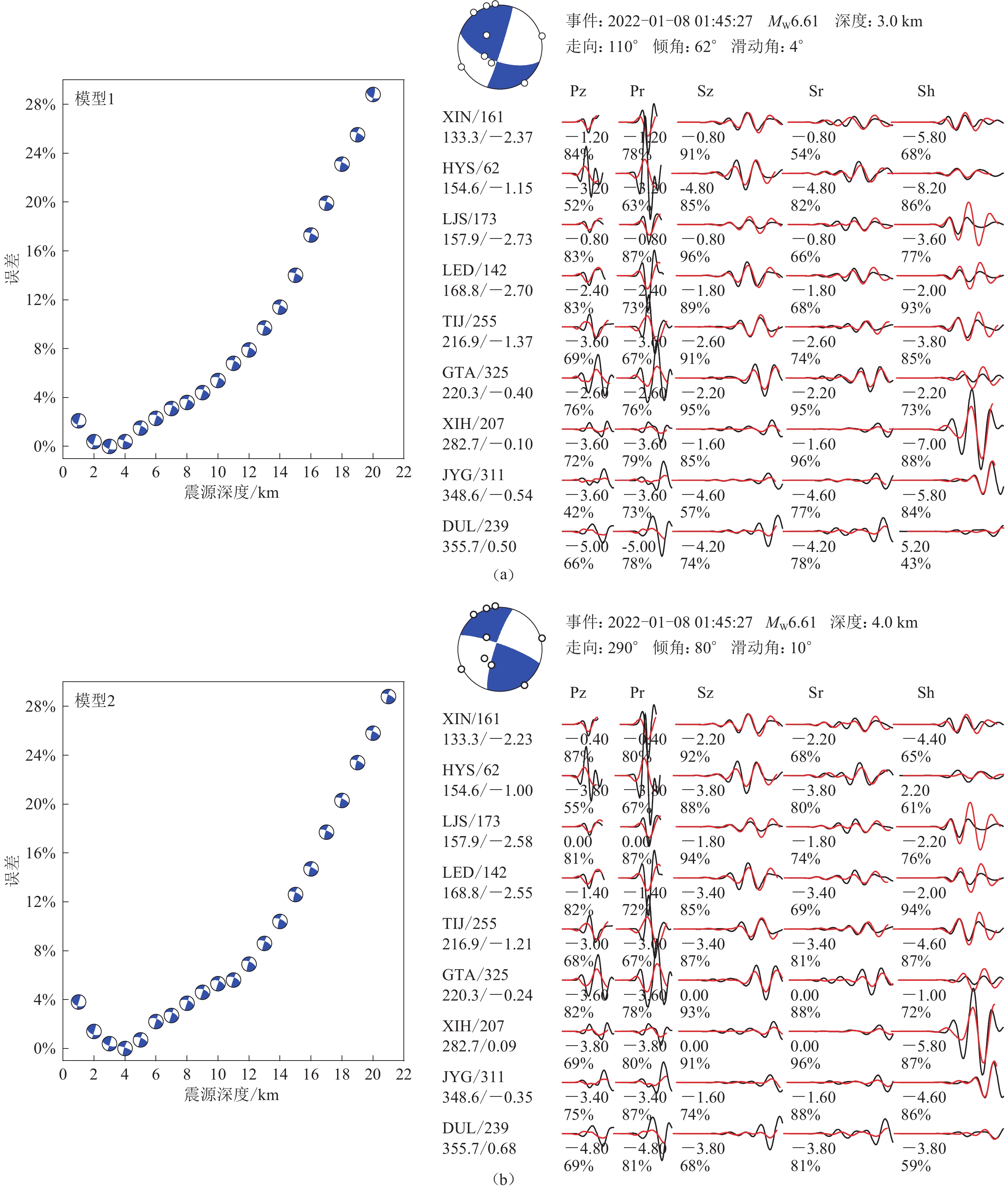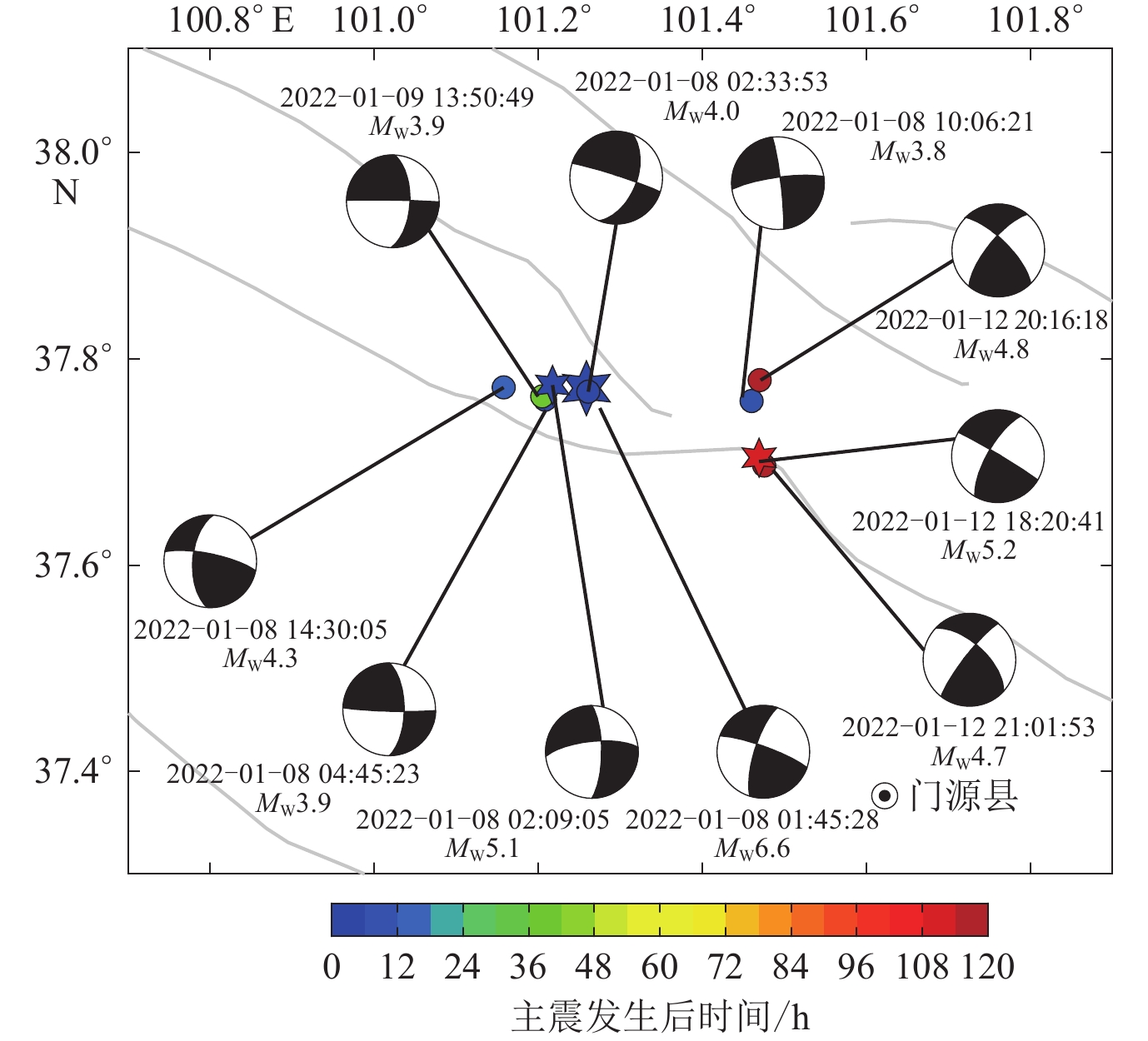Relocation and focal mechanism solutions of the MS6.9 Menyuan earthquake sequence on January 8,2022 in Qinghai Province
-
摘要: 2022年1月8日青海省海北州门源县发生MS6.9地震,震后产生了长约22 km的地表破裂带,青海、甘肃和宁夏等多地震感强烈。本文基于区域地震台网资料,通过多阶段定位方法对门源MS6.9地震早期序列(2022年1月8日至12日)进行了重定位,并利用gCAP方法反演了主震和MS≥3.4余震的震源机制和震源矩心深度,计算了现今应力场体系在门源MS6.9地震震源机制两个节面产生的相对剪应力和正应力。结果表明:门源MS6.9地震的初始破裂深度为7.8 km,震源矩心深度为4 km,地震序列的优势初始破裂深度主要介于7—8 km之间,而MS≥3.4余震的震源矩心深度为3—7 km;该地震序列的震源深度剖面显示震后24个小时内的地震序列长度约为25 km,与地表破裂带的长度大体一致,整体地震序列长度约为30 km,其中1月8日MS6.9主震和MS5.1余震位于余震区西段,1月12日MS5.2余震位于余震区东段。2022年1月8日门源MS6.9主震的震源机制解节面Ⅰ为走向290°、倾角81°、滑动角16°,节面Ⅱ为走向197°、倾角74°、滑动角171°,根据余震展布的总体趋势估计断层面走向为290°,表明此次地震为近乎直立断层面上的一次左旋走滑型事件;MS≥3.4余震的震源机制解显示这些地震主要为走滑型地震,P轴走向从余震区西段到东段之间大体呈现NE向到EW向的变化。现今应力场体系在门源MS6.9主震震源机制解节面Ⅰ上产生的相对剪应力为0.638,而在节面Ⅱ上的相对剪应力为0.522,表明这两个节面均非构造应力场的最大释放节面,这与2016年门源MS6.4地震逆冲型震源机制为构造应力场的最优释放节面有着明显差异。结合地质构造、震源机制和余震展布,2022年1月8日门源MS6.9主震的发震构造可能为冷龙岭断裂西段,其地震断层错动方式为左旋走滑。根据重定位结果、震级-破裂关系以及剪应力结果,本文认为门源地区存在一定的应力积累且应力未得到充分释放,该地区仍存在发生强震的危险。Abstract: On January 8, 2022, an earthquake with MS6.9 occurred in Menyuan County, Haibei Prefecture of Qinghai Province. The earthquake ruptured a nearly 22 km long surface fracture zone and strong tremors were felt through the regions of Qinghai, Gansu and Ningxia regions. In this paper, the early events of the MS6.9 Menyuan earthquake sequence from January 8 to 12, 2022 were relocated by multi-step locating method. Meanwhile, the focal mechanisms and focal depths of the main shock and MS≥3.4 aftershocks were calculated by gCAP method. Based on focal mechanism result of the main shock, the relative shear stress and normal stress on the two nodal planes of the focal mechanism solutions were also calculated under the existing stress field system. The result indicates that the initial rupture depth of MS6.9 Menyuan main shock was 7.8 km, and the centroid depth was 4 km. The dominant initial rupture depths of early earthquake sequence were mainly between 7 km and 8 km, while the centroid depths of MS≥3.4 aftershocks varied between 3 km and 7 km. The focal depth profile shows that the sequence length within 24 hours after the main shock was about 25 km, which was roughly consistent with the length of the surface rupture zone, and the overall sequence length was about 30 km. The MS6.9 main shock and MS5.1 aftershocks on January 8 were located in the western part of the aftershock region, and the MS5.2 earthquake on January 12 was located in the eastern part of the aftershock region. The focal mechanism solution of the MS6.9 main shock was strike 290°, dip 81°, rake 16° for the nodal plane Ⅰ , and strike 197°, dip 74°, rake 171° for the nodal plane Ⅱ . Based on the spatial distribution of aftershocks, it is estimated that the strike of the fault plane is 290º, indicating that the earthquake is a left-lateral strike slip event on a nearly vertical fault plane. The results of focal mechanism solutions of MS≥3.4 aftershocks show that these earthquakes were mainly strike-slip, and from the west to the east of the aftershock region the P-axis azimuths varied from NE to EW. Under the current stress field system, the relative shear stress generated on the nodal plane Ⅰ of focal mechanism of the MS6.9 Menyuan earthquake is 0.638, while on the nodal plane Ⅱ is 0.522. The two nodal planes of focal mechanism are not the maximum released nodal plane of the tectonic stress field, which is obviously different from the thrust focal mechanism of the MS6.4 Menyuan earthquake in 2016, which is the optimal released nodal plane of tectonic stress field. Combined with the geological structure, focal mechanisms and aftershock distribution, the seismogenic structure of MS6.9 Menyuan earthquake on January 8, 2022 may be the western segment of Lenglongling fault, and its seismic dislocation mode is left-lateral strike-slip. According to the results of relocation, the magnitude-rupture relationship and the shear stress, it is concluded that there is a certain stress accumulation and stress has not been fully released in Menyuan area, and the risk of strong earthquakes still exists in this area.
-
Keywords:
- MS6.9 Menyuan earthquake /
- relocation /
- focal mechanism /
- seismogenic structure /
- sliding property
-
-
图 3 2022年1月8日至12日门源MS6.9地震序列重定位震中分布
(a) 重定位后地震随震源深度分布图;(b) 重定位后地震随距离主震的离逝时间t分布图
Figure 3. Relocated epicenters of the MS6.9 Menyuan earthquake sequence in the period of 8 to 12 January 2022
(a) Epicenters distribution with focal depth after relocation;(b) Epicenters distribution of with elapsed time t from the origin time of the main shock
图 1 门源MS6.9地震震中和MS≥6.0历史强震分布(a)、地震序列分布(b)及其M-t图和日频次图(c)
F1:冷龙岭断裂;F2:托莱山断裂;F3:昌马—俄博断裂;F4:祁连山北缘断裂;F5:皇城—双塔断裂
Figure 1. Epicenter of MS6.9 Menyuan earthquake and distribution of historical MS≥6.0 strong earthquakes near the main shock epicenter (a),earthquake sequence (b) and their M-t plot and daily frequencies (c)
F1:Lenlongling fault;F2:Tuolaishan fault;F3:Changma-Ebo fault;F4:Northern Qilianshan fault;F5:Huangcheng-Shuangta fault
5 基于速度模型1 (a)和2 (b)的门源MS6.9地震震源机制-深度误差图(左)和最佳深度处波形拟合图(右)
拟合波形下方的两行数字分别为理论波形(红色)相对实际波形(黑色)的移动时间(单位:s)以及二者的相关系数,波形左侧第一行给出了台站名和方位角(单位:度),第二行给出了震中距(单位:km)和相对偏移时间(单位:s),台站波形按震中距排列
5. Source mechanism-depth error diagram (left) and waveform fitting diagram at optimum depth (right) of the MS6.9 Menyuan earthquake with velocity models 1 (a) and 2 (b)
The numbers of two rows beneath the traces are the time shifts (in second) of synthetics (red) relative to the observations (black) and the corresponding cross-correlation coefficients,respectively. The upper-left corner are stations and azimuths (in degree),respectively. The lower-left corner numbers represent the epicentral distance (in km) and the relative offset time (in second). The waveforms of stations are sorted in epicentral distance
5 基于模型3 (c)的门源MS6.9地震震源机制-深度误差图(左)和最佳深度处波形拟合图(右)
拟合波形下方的两行数字分别为理论波形(红色)相对实际波形(黑色)的移动时间(单位:s)以及二者的相关系数,波形左侧第一行给出了台站名和方位角(单位:度),第二行给出了震中距(单位:km)和相对偏移时间(单位:s),台站波形按震中距排列
5. Source mechanism-depth error diagram (left) and waveform fitting diagram at optimum depth (right) of the MS6.9 Menyuan earthquake with velocity model 3 (c)
The numbers of two rows beneath the traces are the time shifts (in second) of synthetics (red) relative to the observations (black) and the corresponding cross-correlation coefficients,respectively. The upper-left corner are stations and azimuths (in degree),respectively. The lower-left corner numbers represent the epicentral distance (in km) and the relative offset time (in second). The waveforms of stations are sorted in epicentral distance
图 6 本文门源MS6.9地震的震源机制结果与其他作者或机构结果的对比
CENC、青海地震台、王卫民等、赵翠萍等、赵韬等的结果引自Seismology小组(2022),郭祥云等和韩立波等的结果引自中国地震局地球物理研究所(2022),其它结果引自European-Mediterranean Seismological Centre (2022)
Figure 6. Comparison of focal mechanism results of the MS6.9 Menyuan earthquake in this paper with those from other authors or institutions
The results of CENC,Qinghai seismic network,Wang Weimin et al,Zhao Cuiping et al,Zhao Tao et al are from Seismology Group (2022),those of Guo Xiangyun et al and Han Libo et al are from Institute of Geophysics,China Earthquake Administration (2022),and others are from European-Mediterranean Seismological Centre (2022)
表 1 门源地区的P波初始速度模型
Table 1 Initial P-wave velocity model in Menyuan area
层号 顶层深度/km vP/(km·s−1) 1 0 4.50 2 5 5.60 3 10 5.90 4 15 6.00 5 20 6.20 6 25 6.30 7 35 6.40 8 45 6.60 9 55 8.00 表 2 门源地区的P波最小一维速度模型
Table 2 Minimum1-D P-wave velocity model in Menyuan area
层号 h/km vP/(km·s−1) 层号 h/km vP/(km·s−1) 层号 h/km vP/(km·s−1) 1 0.00 4.59 10 4.50 5.29 19 20.00 5.96 2 0.50 4.57 11 5.00 5.65 20 22.00 5.81 3 1.00 4.57 12 6.00 5.21 21 25.00 6.14 4 1.50 4.64 13 8.00 5.64 22 28.00 6.25 5 2.00 4.78 14 10.00 5.86 23 31.00 6.25 6 2.50 4.91 15 12.00 5.74 24 34.00 6.28 7 3.00 5.03 16 14.00 5.71 25 43.00 6.42 8 3.50 5.13 17 16.00 5.85 26 56.00 7.76 9 4.00 5.22 18 18.00 5.85 注:h为顶层深度 表 3 2022年1月8日至12日门源地震序列MS≥3.4地震的震源机制解
Table 3 Focal mechanism solutions of the MS≥3.4 events in the Menyuan earthquake sequence from January 8 to January 12,2022
序号 发震
日期发震
时刻震中位置 深度/km 节面Ⅰ 节面Ⅱ MW 东经/° 北纬/° hP hW 走向/° 倾角/° 滑动角/° 走向/° 倾角/° 滑动角/° 1 2022-01-08 01:45:28 101.258 37.770 7.8 4 290 81 16 197 74 171 6.6 2 2022-01-08 01:55:19 101.253 37.762 7.6 − 主震面波里无解 3 2022-01-08 02:09:05 101.217 37.773 9.0 7 0 73 −161 264 72 −18 5.1 4 2022-01-08 02:33:53 101.261 37.769 8.4 7 21 53 −175 288 86 −37 4.0 5 2022-01-08 04:45:23 101.208 37.761 8.5 7 0 64 176 92 86 26 3.9 6 2022-01-08 10:06:21 101.460* 37.760* 7* 6 353 85 −170 262 80 −5 3.8 7 2022-01-08 14:30:05 101.158 37.773 16.8 5 184 59 165 282 77 32 4.3 8 2022-01-09 13:50:49 101.205 37.764 17.7 7 2 60 −178 271 88 −30 3.9 9 2022-01-12 18:20:41 101.469 37.703 13.6 3 210 72 177 301 87 18 5.2 10 2022-01-12 20:16:18 101.470* 37.780* 8* 7 219 72 161 315 72 19 4.8 11 2022-01-12 21:01:53 101.475 37.697 14.2 4 218 81 152 313 62 10 4.7 注:*为因精定位丢失的地震而采用的原始目录经纬度及深度;hP为初始破裂深度,hW为震源矩心深度。 -
郭鹏,韩竹军,安艳芬,姜文亮,毛泽斌,冯蔚. 2017. 冷龙岭断裂系活动性与2016年门源6.4级地震构造研究[J]. 中国科学:地球科学,47(5):617–630. Guo P,Han Z J,An Y F,Jiang W L,Mao Z B,Feng W. 2017. Activity of the Lenglongling fault system and seismotectonics of the 2016 MS6.4 Menyuan earthquake[J]. Science China Earth Sciences,60(5):929–942. doi: 10.1007/s11430-016-9007-2
郭增建, 秦保燕. 1979. 震源物理[M]. 北京: 地震出版社: 102–160. Guo Z J, Qin B Y. 1979. Physics of Earthquake Foci[M]. Beijing: Seismological Press: 102–160 (in Chinese).
李祥,万永革,崔华伟,高熹微,黄骥超,张珊珊. 2016. 2016年1月21日青海门源MS6.4地震构造应力场[J]. 华北地震科学,34(2):36–41. Li X,Wan Y G,Cui H W,Gao X W,Huang J C,Zhang S S. 2016. Tectonic stress field of 2016,MS6.4 Menyuan,Qinghai earthquake[J]. North China Earthquake Sciences,34(2):36–41 (in Chinese).
龙锋,闻学泽,徐锡伟. 2006. 华北地区地震活断层的震级-破裂长度、破裂面积的经验关系[J]. 地震地质,28(4):511–535. doi: 10.3969/j.issn.0253-4967.2006.04.001 Long F,Wen X Z,Xu X W. 2006. Empirical relationships between magnitude and rupture length,and rupture area,for seismogenic active faults in North China[J]. Seismology and Geology,28(4):511–535 (in Chinese).
龙锋,祁玉萍,易桂喜,吴微微,王光明,赵小艳,彭关灵. 2021. 2021年5月21日云南漾濞MS6.4地震序列重新定位与发震构造分析[J]. 地球物理学报,64(8):2631–2646. Long F,Qi Y P,Yi G X,Wu W W,Wang G M,Zhao X Y,Peng G L. 2021. Relocation of the MS6.4 Yangbi earthquake sequence on May 21,2021 in Yunnan Province and its seismogenic structure analysis[J]. Chinese Journal of Geophysics,64(8):2631–2646 (in Chinese).
青海省地震局. 2022. 青海门源“1·8”6.9级地震发现22公里地表破裂[EB/OL]. [2022-01-08]. https://www.qhdzj.gov.cn/Item/2/20969.aspx. Qinghai Earthquake Agency. 2022. A 22 km surface rupture zone was discovered after“1·8” Qinghai Menyuan MS6.9 earthquake[EB/OL]. [2022-01-08]. https://www.qhdzj.gov.cn/Item/2/20969.aspx (in Chinese).
Seismology小组. 2022. 2022年1月8日青海6.9级地震及5.1级余震的中心解及主震对周围的位移场和应变场及对余震的触发作用和对周围断层的库仑应力影响[EB/OL]. [2022-01-09]. https://mp.weixin.qq.com/s/gOR8-7kAErt-UP5dGzrUeA. Seismology Group. 2022. The central focal mechanism solution of the Qinghai M6.9 earthquake and the aftershock of M5.1 on January 8, 2022 and the influence of the main shock on the displacement and strain fields, the triggering effect on the aftershock and the Coulomb stress on the surrounding faults[EB/OL]. [2022-01-09]. https://mp.weixin.qq.com/s/gOR8-7kAErt-UP5dGzrUeA (in Chinese).
石富强,邵志刚,占伟,丁晓光,朱琳,李玉江. 2018. 青藏高原东北缘活动断裂剪切模量及应力状态数值模拟[J]. 地球物理学报,61(9):3651–3663. doi: 10.6038/cjg2018L0631 Shi F Q,Shao Z G,Zhan W,Ding X G,Zhu L,Li Y J. 2018. Numerical modeling of the shear modulus and stress state of active faults in the northeastern margin of the Tibetan Plateau[J]. Chinese Journal of Geophysics,61(9):3651–3663 (in Chinese).
万永革. 2019. 同一地震多个震源机制中心解的确定[J]. 地球物理学报,62(12):4718–4728. Wang Y G. 2019. Determination of center of several focal mechanisms of the same earthquake[J]. Chinese Journal of Geophysics,62(12):4718–4728 (in Chinese).
万永革. 2020. 震源机制与应力体系关系模拟研究[J]. 地球物理学报,63(6):2281–2296. Wan Y G. 2020. Simulation on relationship between stress regimes and focal mechanisms of earthquakes[J]. Chinese Journal of Geophysics,63(6):2281–2296 (in Chinese).
王椿镛,林中洋,陈学波. 1995. 青海门源—福建宁德地学断面综合地球物理研究[J]. 地球物理学报,38(5):590–598. doi: 10.3321/j.issn:0001-5733.1995.05.005 Wang C Y,Lin Z Y,Chen X B. 1995. Comprehensive study of geophysics on geoscience transect from Menyuan,Qinghai Province,to Ningde,Fujian Province,China[J]. Acta Geophysica Sinica,38(5):590–598 (in Chinese).
王月,胡少乾,何骁慧,郭凯,解孟雨,邓世广,马亚伟. 2021. 2021年5月21日云南漾濞6.4级地震序列重定位及震源机制研究[J]. 地球物理学报,64(12):4510–4525. Wang Y,Hu S Q,He X H,Guo K,Xie M Y,Deng S G,Ma Y W. 2021. Relocation and focal mechanism solutions of the 21 May 2021 MS6.4 Yunnan Yangbi earthquake sequence[J]. Chinese Journal of Geophysics,64(12):4510–4525 (in Chinese).
吴建平,黄媛,张天中,明跃红,房立华. 2009. 汶川MS8.0级地震余震分布及周边区域P波三维速度结构研究[J]. 地球物理学报,52(2):320–328. Wu J P,Huang Y,Zhang T Z,Ming Y H,Fang L H. 2009. Aftershock distribution of the MS8.0 Wenchuan earthquake and three dimensional P-wave velocity structure in and around source region[J]. Chinese Journal of Geophysics,52(2):320–328 (in Chinese).
徐锡伟,吴熙彦,于贵华,谭锡斌,李康. 2017. 中国大陆高震级地震危险区判定的地震地质学标志及其应用[J]. 地震地质,39(2):219–275. Xu X W,Wu X Y,Yu G H,Tan X B,Li K. 2017. Seismo-geological signatures for identifying M≥7.0 earthquake risk areas and their preliminary application in mainland China[J]. Seismology and Geology,39(2):219–275 (in Chinese).
杨志高,张雪梅. 2016. 2016年门源MS6.4地震震区地壳厚度及波速比研究[J]. 地震研究,39(4):566–573. Yang Z G,Zhang X M. 2016. Study on crustal thickness and velocity ratio near Menyuan MS6.4 earthquake zone[J]. Journal of Seismological Research,39(4):566–573 (in Chinese).
尹欣欣,赵林林,杨立明,陈继锋,左可桢,蒲举. 2018. 青海门源MS 6.4地震震源机制解与震源深度研究[J]. 大地测量与地球动力学,38(6):624–628. Yin X X,Zhao L L,Yang L M,Chen J F,Zuo K Z,Pu J. 2018. Research on focal mechanism and south depth of Menyuan,Qinghai MS6.4 earthquake[J]. Journal of Geodesy and Geodynamics,38(6):624–628 (in Chinese).
袁道阳,张培震,刘百篪,甘卫军,毛凤英,王志才,郑文俊,郭华. 2004. 青藏高原东北缘晚第四纪活动构造的几何图像与构造转换[J]. 地质学报,78(2):270–278. Yuan D Y,Zhang P Z,Liu B C,Gan W J,Mao F Y,Wang Z C,Zheng W J,Guo H. 2004. Geometrical imagery and tectonic transformation of Late Quaternary active tectonics in northeastern margin of Qinghai-Xizang Plateau[J]. Acta Geologica Sinica,78(2):270–278 (in Chinese).
中国地震局. 2022. 中国地震局发布青海门源6.9级地震烈度图[EB/OL]. [2022-01-11]. https://www.cea.gov.cn/cea/xwzx/fzjzyw/5646200/index.html. China Earthquake Administration. 2022. China Earthquake Administration issued the seismic intensity distribution of Qinghai Menyuan MS6.9 earthquake[EB/OL]. [2022-01-11]. https://www.cea.gov.cn/cea/xwzx/fzjzyw/5646200/index.html (in Chinese).
中国地震局地球物理研究所. 2022. 2022年01月08日青海海北州门源县6.9级地震科技支撑简报[EB/OL]. [2022-01-10]. https://www.cea-igp.ac.cn/kydt/278809.html. Institute of Geophysics, China Earthquake Administration. 2022. Science and technology support for the M6.9 earthquake in Menyuan County, Haibei Prefecture, Qinghai Province on January 8, 2022[EB/OL]. [2022-01-10]. https://www.cea-igp.ac.cn/kydt/278809.html (in Chinese).
中国新闻网. 2022. 青海门源地震初步排查4人轻伤, 发生强余震可能性较低[EB/OL]. [2022-01-08]. http://www.chinanews.com.cn/sh/2022/01-08/9647113.shtml. ChinaNews. 2022. Preliminary investigation of Qinghai Menyuan earthquake showed that four people were slightly injured and the possibility of strong aftershocks was low[EB/OL]. [2022-01-08]. http://www.chinanews.com.cn/sh/2022/01-08/9647113.shtml (in Chinese).
左可桢,陈继锋. 2018. 门源地区地壳三维体波速度结构及地震重定位研究[J]. 地球物理学报,61(7):2788–2801. doi: 10.6038/cjg2018L0537 Zuo K Z,Chen J F. 2018. 3D body-wave velocity structure of crust and relocation of earthquakes in the Menyuan area[J]. Chinese Journal of Geophysics,61(7):2788–2801 (in Chinese).
周民都,张元生,石雅鏐,张树勋,范兵. 2006. 青藏高原东北缘地壳三维速度结构[J]. 地球物理学进展,21(1):127–134. doi: 10.3969/j.issn.1004-2903.2006.01.019 Zhou M D,Zhang Y S,Shi Y L,Zhang S X,Fan B. 2006. Three-dimensional crustal velocity structure in the northeastern margin of the Qinghai-Tibetan Plateau[J]. Progress in Geophysics,21(1):127–134 (in Chinese).
European-Mediterranean Seismological Centre. 2022. Moment tensors[EB/OL]. [2022-01-11]. https://www.emsc-csem.org/Earthquake/tensors.php.
Klein F W. 2002. User’s Guide to HYPOINVERSE-2000: A Fortran Program to Solve For Earthquake Locations and Magnitudes[R]. U.S. Geological Survey Open-File Report 02-171.
Kissling E. 1988. Geotomography with local earthquake data[J]. Rev Geophys,26(4):659–698. doi: 10.1029/RG026i004p00659
Kissling E,Ellsworth W L,Eberhart-Phillips D,Kradolfer U. 1994. Initial reference models in local earthquake tomography[J]. J Geophys Res:Solid Earth,99(B10):19635–19646. doi: 10.1029/93JB03138
Lasserre C,Gaudemer Y,Tapponnier P,Mériaux A S,van der Woerd J,Yuan D Y,Ryerson F J,Finkel R C,Caffee M W. 2002. Fast Late Pleistocene slip rate on the Leng Long Ling segment of the Haiyuan fault,Qinghai,China[J]. J Geophys Res:Solid Earth,107(B11):2276.
Long F,Wen X Z,Ruan X,Zhao M,Yi G X. 2015. A more accurate relocation of the 2013 MS7.0 Lushan,Sichuan,China,earthquake sequence,and the seismogenic structure analysis[J]. J Seismol,19(3):653–665. doi: 10.1007/s10950-015-9485-0
Paige C C,Saunders M A. 1982. LSQR:An algorithm for sparse linear equations and sparse least squares[J]. ACM Trans Math Softw,8(1):43–71. doi: 10.1145/355984.355989
Tapponnier P,Xu Z Q,Roger F,Meyer B,Arnaud N,Wittlinger G,Yang J S. 2001. Oblique stepwise rise and growth of the Tibet Plateau[J]. Science,294(5547):1671–1677. doi: 10.1126/science.105978
Waldhauser F,Ellsworth W L. 2000. A double-difference earthquake location algorithm:Method and application to the northern Hayward fault,California[J]. Bull Seismol Soc Am,90(6):1353–1368. doi: 10.1785/0120000006
Wan Y G. 2010. Contemporary tectonic stress field in China[J]. Earthquake Science,23(4):377–386. doi: 10.1007/s11589-010-0735-5
Wells D L,Coppersmith K J. 1994. New empirical relationships among magnitude,rupture length,rupture width,rupture area,and surface displacement[J]. Bull Seismol Soc Am,84(4):974–1002.
Yang H F, Wang D, Guo R M, Xie M Y, Zang Y, Wang Y, Yao Q, Cheng C, An Y R, Zhang Y Y. 2022. Rapid report of the 8 January 2022 MS6.9 Menyuan earthquake, Qinghai, China[J/OL]. Earthquake Research Advances, https://doi.org/10.1016/j.eqrea.2022.100113.
Zhu L P,Helmberger D V. 1996. Advancement in source estimation techniques using broadband regional seismograms[J]. Bull Seismol Soc Am,86(5):1634–1641.
Zhu L P,Ben-Zion Y. 2013. Parametrization of general seismic potency and moment tensors for source inversion of seismic waveform data[J]. Geophys J Int,194(2):839–843. doi: 10.1093/gji/ggt137
Zhu L P,Rivera L A. 2002. A note on the dynamic and static displacements from a point source in multilayered media[J]. Geophys J Int,148(3):619–627. doi: 10.1046/j.1365-246X.2002.01610.x





 下载:
下载:








